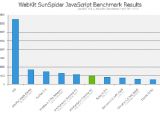In the past seven weeks since Microsoft offered the first public taste of Internet Explorer 9, the browser evolved, and a new development milestone is available for download today, May 5th, to early adopters. Internet Explorer 9 Platform Preview 2 is now live on IETestDrive (www.ietestdrive.com), allowing testers to try out first-hand the advances made with the next iteration of IE in this second Preview Build, compared with the Platform Preview 1 release. The evolution is quite consistent, with the company’s vision for same markup having been pushed forward, with performance improvements, modern web standard-support enhancements, and a work done on hardware acceleration.
Along with Preview 2, new tests designed to highlights the gap between IE9 and rival browsers also went live on IETestDrive. There are some 10-12 new developer samples on the IE9 Test Drive website designed to allow early adopters to test IE9 performance, graphics and HTML5.
“I think the most critical thing for people to see in this second preview is around two words: same markup. Same markup and developer expectations. There’s a community of developers that today goes through a lot of pain and suffering to make things work on the web,” Internet Explorer General Manager Dean Hachamovitch noted over the phone earlier this week. In this sense, Platform Preview Build 2 brings a comprehensive change for developers in terms of the “same markup” vision.
Same markup
The concept of same markup involves enabling developers to write cross-browser code. Code that, once authored, will work seamlessly across all browsers, without devs needing to adapt their work over and over again just to compensate for the differences between the various web browsers available on the market today. Same markup in this context implies not only that browser developers such as Microsoft, Mozilla, Google and Apple cooperate to ensure that their browsers support a set of features that will allow HTML, JavaScript, and CSS to just work, but also that web developers leverage the features available.
The Acid2 and Acid3 Tests are currently referenced as the de facto measuring tools for modern web-standard support, although there are inherent issues with both. However, with Internet Explorer 9, Microsoft has entered the Acid3 Test race, and it’s getting closer and closer to the perfect score. While the original Windows Internet Explorer Platform Preview only scored 55 out of 100 points in Acid3, IE8 Platform Preview 2 is now up to 68/100.
Each point added to the IE9 score in Acid 3 represents a step forward for Microsoft toward allowing developers to write code once, and have it work across all browsers.
Additional work needed “It starts with IE9,” Hachamovitch told me. But there is additional work being done by the Redmond company with the goal of same markup in mind. In this sense, Hachamovitch shared with me that Microsoft had worked to submit additional tests to the working groups at the World Wide Web Consortium (W3C). The IE GM underlined that Microsoft continued to remain committed to collaborating with the standards community. “Creating, submitting, and revising comprehensive test cases that are the only definitive way developers and browser manufactures can responsibly test and design for same markup,” a Microsoft spokesperson explained. In correlation with the Acid 3 Test, Microsoft’s work to embrace web standards with IE9 can also be illustrated with the no less than 192 tests submitted to the W3C, 88 of them new ones.
The general tendency is to blame older versions of Internet Explorer for the differences in markup, and, of course, browsers such as IE6 and IE7 are easy targets in this regard. But it’s not all about IE. There are differences in web-standard implementations between all browsers, including Chrome, Firefox and Safari. There are even differences between flavors of WebKit. All such differences add to the time and effort web developers need to put into building websites.
“Fundamentally, developers have this amazing power, to make the web great. The obstacle for them today is how much time they spend working through the differences from browser to browser,” Hachamovitch said. Fact is that developers asking for “same markup” will need to hold Mozilla, Google and Apple to the same standards as Microsoft. Same markup will only become a reality if all browser platforms embrace web standards cohesively and support the same range of features. This will permit developers to write HTML, CSS, JS, DOM, SVG, etc. once and have it work consistently, independent of the browser end users are running.
According to Hachamovitch, Microsoft is collaborating well with Mozilla, Apple and Google in this regard. But, at the same time, same markup does not only mean that Internet Explorer 9 needs to evolve, but also that rival browser makers also adapt their code. As the Acid 3 Test score illustrates, IE9 embraces more of HTML5, CSS3, DOM, and SVG than ever before.
Enhanced performance
As you can see from the image on the left, IE9 Platform Preview 2 is now faster than its predecessor. The results come from Webkit.org’s SunSpider benchmark test, and the Redmond company managed to shave over 100 good milliseconds off IE9’s performance. IE9 Platform Preview 2 is 117 milliseconds faster than IE9 Platform Preview 1, while both are faster compared with Firefox 3.6 in terms of JavaScript performance. IE9 features a new JS engine, codenamed Chakra, illustrating a strong focus of the software giant to close the gap that separated IE7 from its rivals.
Hardware acceleration
IE9 Platform Preview 2 also pushes forward hardware acceleration. Hachamovitch made it clear that web-standard support, JS performance and hardware acceleration ultimately worked hand in hand to deliver the best possible experience to end users. I have already been able to see Internet Explorer 9 Platform Preview 2 put through three new hardware-acceleration tests in comparison with Firefox and Chrome.
The advances that Microsoft has made in terms of standards support, especially around HTML5 and SVG, and utilizing the power of the GPU (graphics processing unit) in relation to DirectX 11 APIs such as DirectWrite and Direct2D really make IE9 stand out from the crowd. In two of the tests, Browser Flip and Flickr photos, IE9 holds steady at 60 frames per second, and delivers a smooth experience, while Chrome struggles to render the content correctly.
It starts with IE9
When Hachamovitch says that it starts with IE9, it means that the work Microsoft is doing with the next generation of Internet Explorer is a great chance for rival browser makers, developers and the W3C to work together like they have failed do to in the past and rally themselves in a singular standardization effort. The nuances between how browser makers understand to tend to the WebKit rendering engine in different browser, are a clear illustration that finding common ground in terms of web standards would perhaps make much more sense. As I’ve said above, it’s not just about Microsoft changing IE, but also about Mozilla, Apple, Google, etc. changing their browsers as well.
Internet Explorer 9 (IE9) Platform Preview 2 Build 1.9.7766.6000 is available for download here.

 14 DAY TRIAL //
14 DAY TRIAL // 




